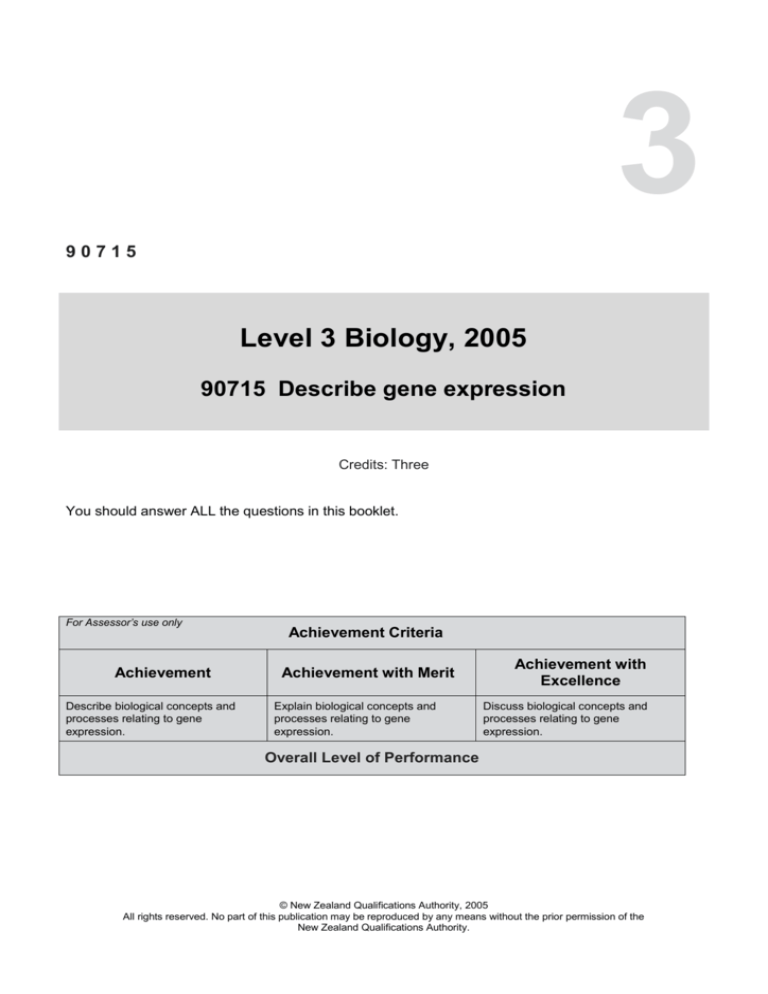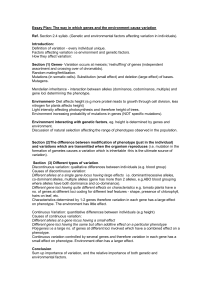
3
90715
Level 3 Biology, 2005
90715 Describe gene expression
Credits: Three
You should answer ALL the questions in this booklet.
For Assessor’s use only
Achievement
Describe biological concepts and
processes relating to gene
expression.
Achievement Criteria
Achievement with Merit
Explain biological concepts and
processes relating to gene
expression.
Achievement with
Excellence
Discuss biological concepts and
processes relating to gene
expression.
Overall Level of Performance
© New Zealand Qualifications Authority, 2005
All rights reserved. No part of this publication may be reproduced by any means without the prior permission of the
New Zealand Qualifications Authority.
You are advised to spend 40 minutes answering the questions in this booklet.
QUESTION ONE
The left side of the diagram below shows how a eukaryote synthesises mRNA as part of normal
protein synthesis. The right side shows how the mRNA formed can also be used to make a special
form of DNA called cDNA (complementary DNA). This cDNA is the form of DNA that is needed if
human genes are to be inserted into bacteria for genetic engineering purposes.
[FOR COPYRIGHT REASONS,
THIS RESOURCE CANNOT
BE REPRODUCED HERE.
SEE BELOW.]
Lea C, Lowrie P, and McGuigan S, AS Biology for AQA Specification B – Resource Pack, Heinemann, 2000.
(a)
Describe how mRNA is formed from DNA as shown by the first arrow in the diagram.
(b)
Explain the role of tRNA in the formation of the protein.
(c)
Explain why Okazaki fragments are formed when DNA replicates.
(d)
The cDNA shown on the right of the diagram can also be synthesised using the analysis of the
amino acids of the protein formed by translation on the left. However, if scientists use this
analysis of the protein to form cDNA, it may not have the same code sequence as cDNA formed
using mRNA. Discuss why this situation occurs.
L3 Biology 2005, 90715 – page 2 of 4
QUESTION TWO
The base sequence from the end of a gene is shown below. Use it and the table given to answer the
questions that follow.
[FOR COPYRIGHT REASONS,
THIS RESOURCE CANNOT
BE REPRODUCED HERE.
SEE BELOW.]
Tracey Greenwood, Richard Allan, Year 12 Biology 2003, Biozone, Hamilton, 2003, p 287.
(a)
Use the table to determine the sequence of amino acids formed from this portion of the gene.
(b)
The table is in the form of codons of mRNA. Codons are made up of nucleotides.
Describe what makes up the nucleotides of codons.
(c)
Discuss why a substitution point mutation at the position marked X will have very little effect
on the polypeptide formed, whereas a deletion point mutation at position X would prevent
production of the same protein.
QUESTION THREE
The development of coat colour patterns in cats is very complex. It involves at least 10 genes, each of
which has a different effect on the phenotype. Effects include different colours, spots, different
intensities, stripes, colour in different parts of the body and texture.
(a)
Explain why the 10 genes involved in coat colour patterns in cats could not really be called an
example of polygene inheritance.
L3 Biology 2005, 90715 – page 3 of 4
(b)
There are 3 main genes that control the metabolic pathway that produces the pigment melanin in
cats. Melanin production starts with the amino acid tyrosine. There are two forms of melanin:
eumelanin (black) and phaeomelanin (orange/yellow).
The metabolic pathway for this is shown below.
Dominant alleles are needed at each locus to complete all steps of the pathway to produce
phaeomelanin (orange).
Discuss how this pathway shows epistasis. In your discussion include the effect on the
phenotype if one of the genes was homozygous recessive.
The first gene in the pathway has four alleles. Allele C produces an enzyme that gives full coat colour.
It is dominant over the alleles cb (Burmese) and cs (Siamese). There is another allele, c, recessive to all
three other alleles, that does not produce an active enzyme at all so the cats are albino. The alleles cb
and cs are incompletely dominant with respect to each other.
(c)
Describe the term incomplete dominance with reference to this series of alleles.
(d)
Explain how four alleles can be involved in the first step of the metabolic pathway.
(e)
Consider the other two genes from this pathway.
•
The allele B produces eumelanin (black pigment) and is dominant to b. Homozygous
recessive bb cats are brown or chocolate.
•
The orange gene (O or o) is located on the X chromosome. X with O produces an enzyme
that results in the conversion of eumelanin (black) to phaeomelanin (red/orange/yellow).
The X with o cannot carry out this conversion.
(i)
Use this information to explain why male cats are nearly always either orange or black
whereas females are often an orange-black mixture called tortoiseshell.
(ii)
Occasionally a male cat with tortoiseshell features is born. Such male cats are sterile.
Discuss how male tortoiseshell cats can occur and why they are sterile. You may use
Punnett diagrams in your answer.
L3 Biology 2005, 90715 – page 4 of 4








